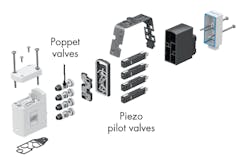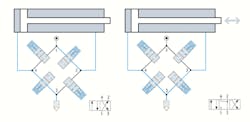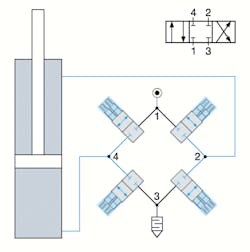Veterans of motion control might roll their eyes at the thought of yet another industry era with a number attached to it by a decimal point. Add “cyber” anywhere in the mix and all of a sudden people skilled in the flow of fluids must now be masters of data flow too. The VTEM Motion Terminal is a cyber-physical system (CPS). It uses an array of intelligent pneumatic valves that are all identical. This means machine builders don’t need to specify or keep dozens of different pneumatic valves in stock for a given machine. Instead, the VTEM Motion Terminal uses multiple identical valves, with functionality defined by downloadable apps.
Ten downloadable apps are available for download, with 40 more apps planned. Each unique combination of apps changes the motion functionality, giving OEMs a new flexible motion control platform.
The motion terminal conforms to the National Science Foundation’s definition of CPS as engineered systems that are built from, and depend upon, the seamless integration of computational algorithms and physical components. The foundation envisions that, “Advances in CPS will enable capability, adaptability, scalability, resiliency, safety, security, and usability that will far exceed the simple embedded systems of today. CPS technology will transform the way people interact with engineered systems—just as the Internet has transformed the way people interact with information.”
With a single intelligent valve slice potentially providing the functionality of up to 50 individual components, a CPS such as the VTEM Motion Terminal opens the door to standardized platform concepts for systems and system modules. Standardization considerably reduces hardware costs all through the supply chain as the machine builders must fewer components. By focusing on a flexible CPS platform right from the start, even the planning stage, the search for suitable products and suppliers can be shortened.
Benefits of the Platform
Design is one of the biggest costs in machine and system building, accounting for approximately 25 to 30% of total cost. A CPS, such as the VTEM Motion Terminal, enables significant time gains and savings compared with a conventional valve terminal platform. In some cases, the time saved compared with designing and parameterizing a modular valve terminal and additional individual components is up to 70%.
The adaptations are implemented digitally on the product itself, so there is no need to reconfigure the valve terminal, download and create the CAD model, or adapt the hole pattern and assembly drawing, including a parts list. Designers will find the creation of electrical circuit diagrams, the documentation including spare and wearing parts lists, and the approval process speeded up.
Lower costs for data management, logistics, and warehousing—With many fewer components, CPS minimizes the process steps required for logistics and warehousing and reduces the cost of data management and maintenance. The OEMs and end integrate new functions simply by purchasing the relevant motion app licenses.
Greater reliability and reduced effort due to standardization—Reducing system complexity is becoming more and more important given that human error is increasingly being identified as the cause of system failures. Solutions with intelligent function integration and fewer interfaces are therefore ideal for achieving maximum efficiency. This reduces assembly work as well as possible errors and any queries that may arise. Having just one standardized component optimizes process sequences for a wide range of functions.
Easier replication of pneumatic systems—Coordinating individual process steps, such as setting the travel speeds of cylinders, is often a time-intensive process in conventional mechatronic systems. CPS solutions generally do not involve complex manual setting processes for components that may sometimes be hard to reach, and they are also self-regulating and self-optimizing in terms of energy consumption. These are clear benefits for machine builders.
Travel speed of each individual cylinder can be defined with just a few clicks via the app’s parameter records; this also rules out tampering. The app saves between three and four minutes of setting time per flow control valve. Looking at the annual production of a series machine builder, the cumulative time savings can be substantial. Another big advantage is that all system configurations are completely identical.
Configuration and parameterization—If you wanted to precisely and quickly control the pressure to compensate for a pressure drop caused by friction in the compressed air line, you needed to determine the parameters empirically, i.e. a higher setpoint value and the time that the pressure stays at this value before it drops back down again to the target value. Using the sensor intelligence and software modules in cyber-physical systems, these tasks are unnecessary. The motion terminal has a model-based proportional pressure regulation app for this process. The app can also actively and autonomously respond to changing parameters, such as fluctuations in input pressure.
Combining maximum productivity with energy efficiency—The motion terminal makes system operation productive, energy efficient, and cost effective. Reconfiguration and adjustments are carried out using software. Diagnostics and intelligent apps prevent stoppages, production errors, and contribute to a fast return on investment.
Shorter setup times and adjustment at the touch of a button—Format changeovers usually involve changing components such as grippers. This in turn requires adapting pressures or flow rates and travel speeds or entire functions. The motion terminal eliminates many manual procedures – and sources of error. Reconfiguration and adjustments are done via the app or automatically via the PLC, which means that the performance and/or processes of all machines during format changes or in series machines can be improved at the touch of a button.
Integrated knowledge protection with apps—Function configuration via apps will stop unauthorized parties from analyzing and identifying future functionalities and system designs.
Condition monitoring—In terms of their basic structure, CPS are mechatronic systems. In addition, they also have integrated smart sensors and greater software intelligence. One important application for CPS is to determine external conditions – for example, compressed air leakage – without the need for additional sensors, and then share this information with other systems.
Algorithms Define Valve Function
Smart valve technology in the motion terminalis realized by a bridge circuit with integrated sensors that is made up of four 2/2-way valves. Pressurizing and exhausting independent of each other is the key principle that allows a single valve to perform a wide range of conventional valve functions. This valve technology can also be used to carry out proportional pressure regulation and complex control solutions, such as Soft Stop.
The concept behind the motion terminal in this system relies on piezo valves to control the main valves, providing proportional pilot control with minimal energy consumption.
Actuating each of four poppet valves individually provides high flexibility, so a single valve can function as any of 50 different types of conventional valves. Four piezo pilot piezo valves provide accurate, proportional actuation of the diaphragm poppet valves. In addition, valve electronics with integrated stroke, pressure, and temperature sensors provide precise control and transparent condition monitoring.
The motion terminal’s integrated processor coordinates the actions of sensors, pilot, and poppet valves based on application algorithms. Changing an app modifies the interactions of the individual components and gives the intelligent valve its flexibility. Internal pressure measurement sensors simplify configuration and provide for diagnostic functionality. VTEM Motion Terminals are provided in either four-valve or eight-valve platforms.
With pneumatic functions no longer dependent upon mechanical hardware, but simply assigned using apps, one valve type can execute a variety of pneumatic functions.
For example, a standard valve supplies a pressure of 6 bar to the compressed air network. At the end of the movement, the full supply pressure of 6 bar is built up in the drive chamber, irrespective of the moving load. With the motion terminal, depending on the load and the movement phase, the actual pressure in the drive is reduced to the level required using throttled pressurization. You could set a lower pressure for the return (no-load) stroke of a pressing application, for example.
For downward vertical movements, the motion terminal uses the force of gravity to save energy by reducing pressure. In this example, the array of valves is controlled to mimic a closed-center condition of a conventional valve to hold a vertical load.
Apps Define Valve Functions
Valve functionality of the VTEM Motion Terminal is controlled by downloadable apps so that one valve can replace up to 50 different components, depending on the app or combinations of apps resident in the integrated processor. Following is a summary of the first 10 of a planned 50 applications for the VTEM motion controller. As noted, some apps require auxiliary components.
Soft stop app—Designers can shorten cycle times by up to 70% with this app. The soft stop app allows implementing highly dynamic, yet gentle positioning motion without having to use shock absorbers. This reduces maintenance, increases the service life of systems, and enhances productivity. (Required accessory: position sensor SDAP)
ECO drive app—This app reduces costs by operating an actuator with the minimum pressure necessary for the load. This eliminates the rise in pressure in the drive chamber at the end of the movement, allowing energy savings of up to 70%. (Required accessory: cylinder limit switch)
Leakage diagnostics app—Use of this app leads to lower system downtimes and faster fault detection. Separate diagnostic cycles and defined threshold values enable the intelligent valve to detect and localize individual leaks.
Directional control valve function app—This permits modifying the intelligent valve’s standard directional control functions, including replicating 4/2, 4/3, and 3/2 at any time(even during operation), and as often as necessary. Therefore, operators can respond to and change machine requirements at the touch of a button with a single valve platform.
Proportional pressure regulator app—This app saves space and hardware costs by combining the functions of two individual and independent proportional pressure regulators in a single valve. The app also accommodates vacuum.
Model-based proportional pressure regulation app—By storing boundary parameters for the system, such as tube length, tube diameter, and cylinder size, this anticipatory control system ensures maximum accuracy as the app compensates for decreases in pressure and volume. Essentially, model-based control can eliminate the need for external sensors.
Selectable pressure level app—This app saves energy by setting several pressure levels. Set the pressure for selected movements to the desired level. Additionally, this app can control speed by adjusting the flow control valve setting.
Supply and exhaust air flow control app—By replacing separate flow control valves on the actuator, this app allows setting tamper-proof travel speeds quickly and conveniently. New motion sequences, such as a dynamic flow control adjustment, can also be implemented.
Presetting travel time app—Simply entering the travel time for advancing and retracting motions provides quick and easy commissioning. The exhaust air flow control function adapts itself to the travel time and then maintains it. The system automatically adjusts the values in case of influences such as increased friction due to wear. (Required accessory: cylinder limit switch)
Proportional directional control valve app—Two proportional flow control functions have been integrated in one valve and on one platform, resulting in an economical and compact operation.
Craig Correia is director, Process Industries—North America at Festo Corp., Islandia, N.Y.
About the Author
Craig Correia
Director, Process Industries—North America
Craig Correia is the director of Life Science & Process Industries, North America at Festo. For the past 20 years, he has held technical, management, and business development roles at the company, including two years as global industry segment manager at Festo headquarters in Esslingen, Germany. He has a B.S. in mechanical engineering from the University of Massachusetts and an M.B.A. from Providence College. Correia is an active member and has served on committees with the International Society for Pharmaceutical Engineering (ISPE) and the Measurement, Control & Automation Association (MCAA).

Leaders relevant to this article:




